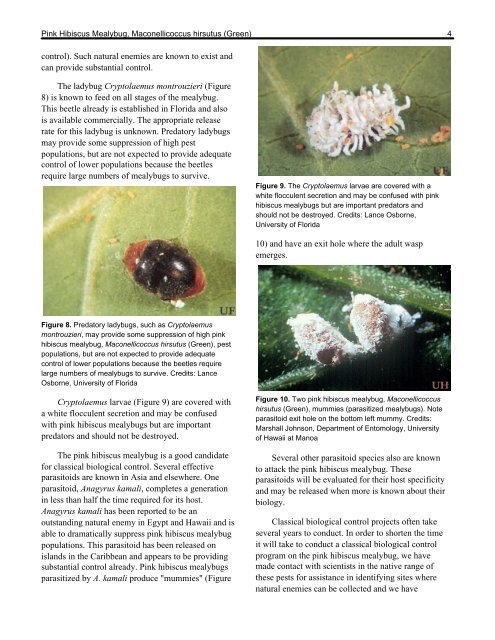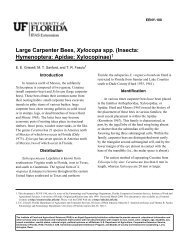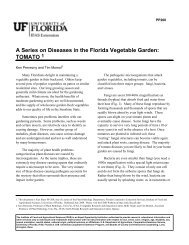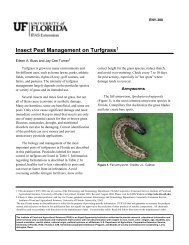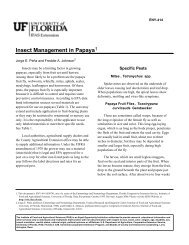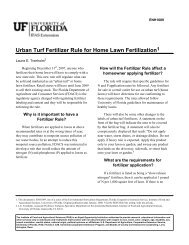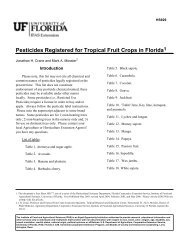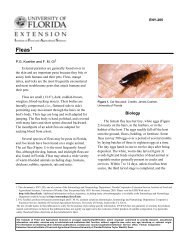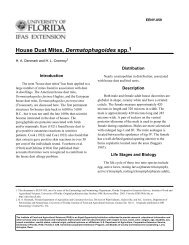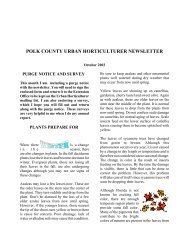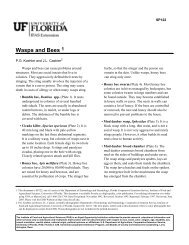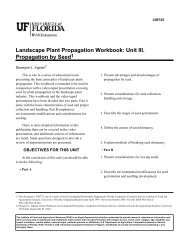Pink Hibiscus Mealybug, Maconellicoccus hirsutus - Polk County ...
Pink Hibiscus Mealybug, Maconellicoccus hirsutus - Polk County ...
Pink Hibiscus Mealybug, Maconellicoccus hirsutus - Polk County ...
You also want an ePaper? Increase the reach of your titles
YUMPU automatically turns print PDFs into web optimized ePapers that Google loves.
<strong>Pink</strong> <strong>Hibiscus</strong> <strong>Mealybug</strong>, <strong>Maconellicoccus</strong> <strong>hirsutus</strong> (Green) 4<br />
control). Such natural enemies are known to exist and<br />
can provide substantial control.<br />
The ladybug Cryptolaemus montrouzieri (Figure<br />
8) is known to feed on all stages of the mealybug.<br />
This beetle already is established in Florida and also<br />
is available commercially. The appropriate release<br />
rate for this ladybug is unknown. Predatory ladybugs<br />
may provide some suppression of high pest<br />
populations, but are not expected to provide adequate<br />
control of lower populations because the beetles<br />
require large numbers of mealybugs to survive.<br />
Figure 9. The Cryptolaemus larvae are covered with a<br />
white flocculent secretion and may be confused with pink<br />
hibiscus mealybugs but are important predators and<br />
should not be destroyed. Credits: Lance Osborne,<br />
University of Florida<br />
10) and have an exit hole where the adult wasp<br />
emerges.<br />
Figure 8. Predatory ladybugs, such as Cryptolaemus<br />
montrouzieri, may provide some suppression of high pink<br />
hibiscus mealybug, <strong>Maconellicoccus</strong> <strong>hirsutus</strong> (Green), pest<br />
populations, but are not expected to provide adequate<br />
control of lower populations because the beetles require<br />
large numbers of mealybugs to survive. Credits: Lance<br />
Osborne, University of Florida<br />
Cryptolaemus larvae (Figure 9) are covered with<br />
a white flocculent secretion and may be confused<br />
with pink hibiscus mealybugs but are important<br />
predators and should not be destroyed.<br />
The pink hibiscus mealybug is a good candidate<br />
for classical biological control. Several effective<br />
parasitoids are known in Asia and elsewhere. One<br />
parasitoid, Anagyrus kamali, completes a generation<br />
in less than half the time required for its host.<br />
Anagyrus kamali has been reported to be an<br />
outstanding natural enemy in Egypt and Hawaii and is<br />
able to dramatically suppress pink hibiscus mealybug<br />
populations. This parasitoid has been released on<br />
islands in the Caribbean and appears to be providing<br />
substantial control already. <strong>Pink</strong> hibiscus mealybugs<br />
parasitized by A. kamali produce "mummies" (Figure<br />
Figure 10. Two pink hibiscus mealybug, <strong>Maconellicoccus</strong><br />
<strong>hirsutus</strong> (Green), mummies (parasitized mealybugs). Note<br />
parasitoid exit hole on the bottom left mummy. Credits:<br />
Marshall Johnson, Department of Entomology, University<br />
of Hawaii at Manoa<br />
Several other parasitoid species also are known<br />
to attack the pink hibiscus mealybug. These<br />
parasitoids will be evaluated for their host specificity<br />
and may be released when more is known about their<br />
biology.<br />
Classical biological control projects often take<br />
several years to conduct. In order to shorten the time<br />
it will take to conduct a classical biological control<br />
program on the pink hibiscus mealybug, we have<br />
made contact with scientists in the native range of<br />
these pests for assistance in identifying sites where<br />
natural enemies can be collected and we have


